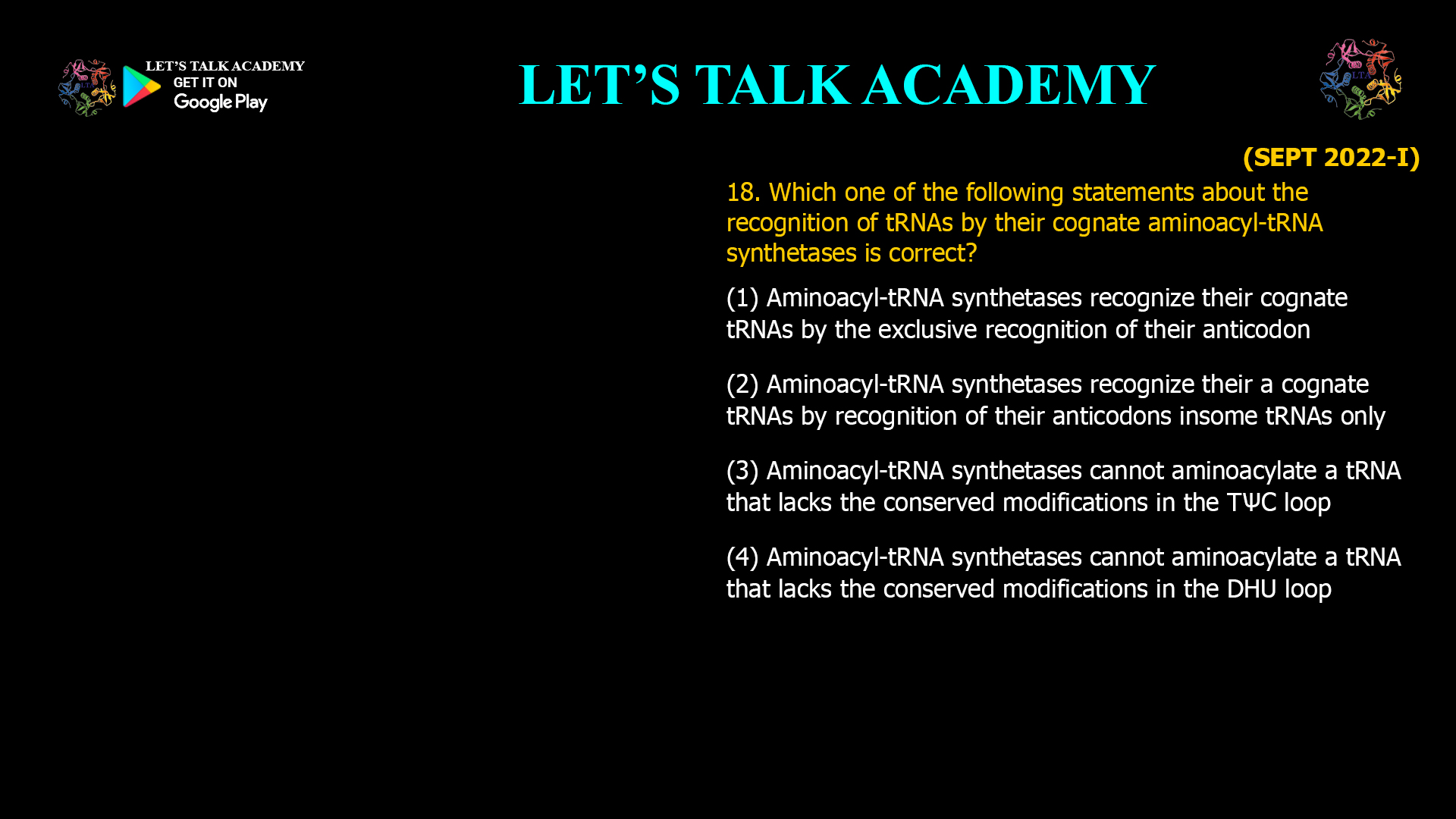- Which one of the following statements about the recognition of tRNAs by their cognate aminoacyl-tRNAsynthetases is correct?
(1) Aminoacyl-tRNAsynthetases recognize theircognate tRNAs by the exclusive recognition of theiranticodon
(2) Aminoacyl-tRNAsynthetases recognize their a cognate tRNAs by recognition of their anticodons insome tRNAs only
(3) Aminoacyl-tRNAsynthetases cannot aminoacylate a tRNA that lacks the conserved modifications in the TѰC loop
(4) Aminoacyl-tRNAsynthetases cannot aminoacylate a tRNA that lacks the conserved modifications in the DHU loopHow Aminoacyl-tRNA Synthetases Recognize Their Cognate tRNAs: The Role of Anticodon and Other tRNA Elements
Aminoacyl-tRNA synthetases (aaRSs) are essential enzymes that attach the correct amino acid to its corresponding tRNA, a critical step in ensuring the fidelity of protein synthesis. A key question in molecular biology is how these enzymes recognize their cognate tRNAs among many similar molecules.
Understanding tRNA Recognition by Aminoacyl-tRNA Synthetases
-
Not exclusively anticodon recognition:
While the anticodon loop of tRNA is important for codon recognition during translation, aaRSs do not rely solely on the anticodon for tRNA recognition. Instead, they use a combination of structural and sequence elements. -
Identity elements beyond the anticodon:
Recognition involves multiple identity determinants located in different parts of the tRNA molecule, such as the acceptor stem, D-arm, and variable loop, in addition to the anticodon loop. These elements contribute to the overall three-dimensional structure and sequence specificity. -
Selective recognition in some cases:
For some tRNAs, the anticodon plays a more prominent role in recognition, but this is not universal across all aaRSs. -
Conserved modifications:
Modifications in the tRNA, including those in the TΨC and D loops, can influence recognition and aminoacylation efficiency but are not absolutely required for all synthetases.
Evaluating the Given Options
Option Description Correctness (1) aaRS recognize tRNAs exclusively by anticodon Incorrect; recognition is more complex (2) aaRS recognize anticodons in some tRNAs only Correct; anticodon recognition is important in some but not all cases (3) aaRS cannot aminoacylate tRNA lacking conserved modifications in TΨC loop Incorrect; modifications influence but are not always essential (4) aaRS cannot aminoacylate tRNA lacking conserved modifications in DHU loop Incorrect; similar reasoning as above
Scientific Insights
-
Studies show that initial binding of tRNA by aaRS is often driven by electrostatic interactions with the phosphate backbone and overall tRNA shape.
-
Specificity is enhanced by recognizing identity elements scattered across the tRNA molecule.
-
The anticodon loop is a critical determinant for some aaRSs but not universally exclusive.
-
Modifications in the TΨC and DHU loops generally stabilize tRNA structure rather than serve as strict recognition signals.
Keywords for SEO Optimization
-
Aminoacyl-tRNA synthetase tRNA recognition
-
Anticodon role in tRNA specificity
-
tRNA identity elements
-
Protein synthesis fidelity
-
tRNA modifications and aminoacylation
-
aaRS substrate specificity
-
Molecular recognition of tRNA
-
tRNA structure-function relationship
-
Genetic code translation accuracy
-
Enzyme-tRNA interaction
Conclusion
Aminoacyl-tRNA synthetases do not recognize their cognate tRNAs exclusively by the anticodon. Instead, anticodon recognition is important only for some tRNAs, while the enzyme also relies on other structural and sequence identity elements distributed throughout the tRNA molecule. Conserved modifications in the TΨC or DHU loops are not absolute requirements for aminoacylation.
Correct answer: (2) Aminoacyl-tRNAsynthetases recognize their cognate tRNAs by recognition of their anticodons in some tRNAs only
-



